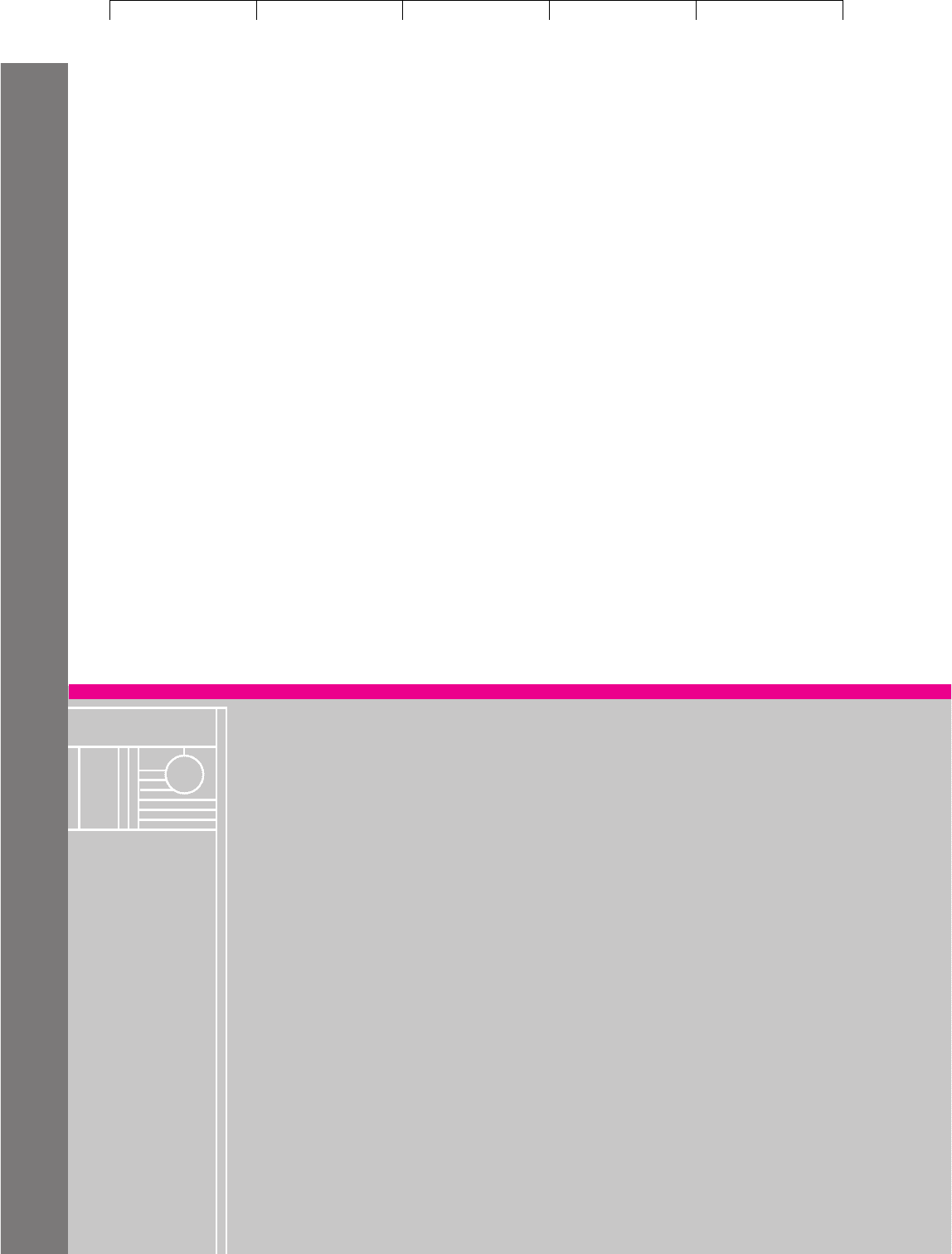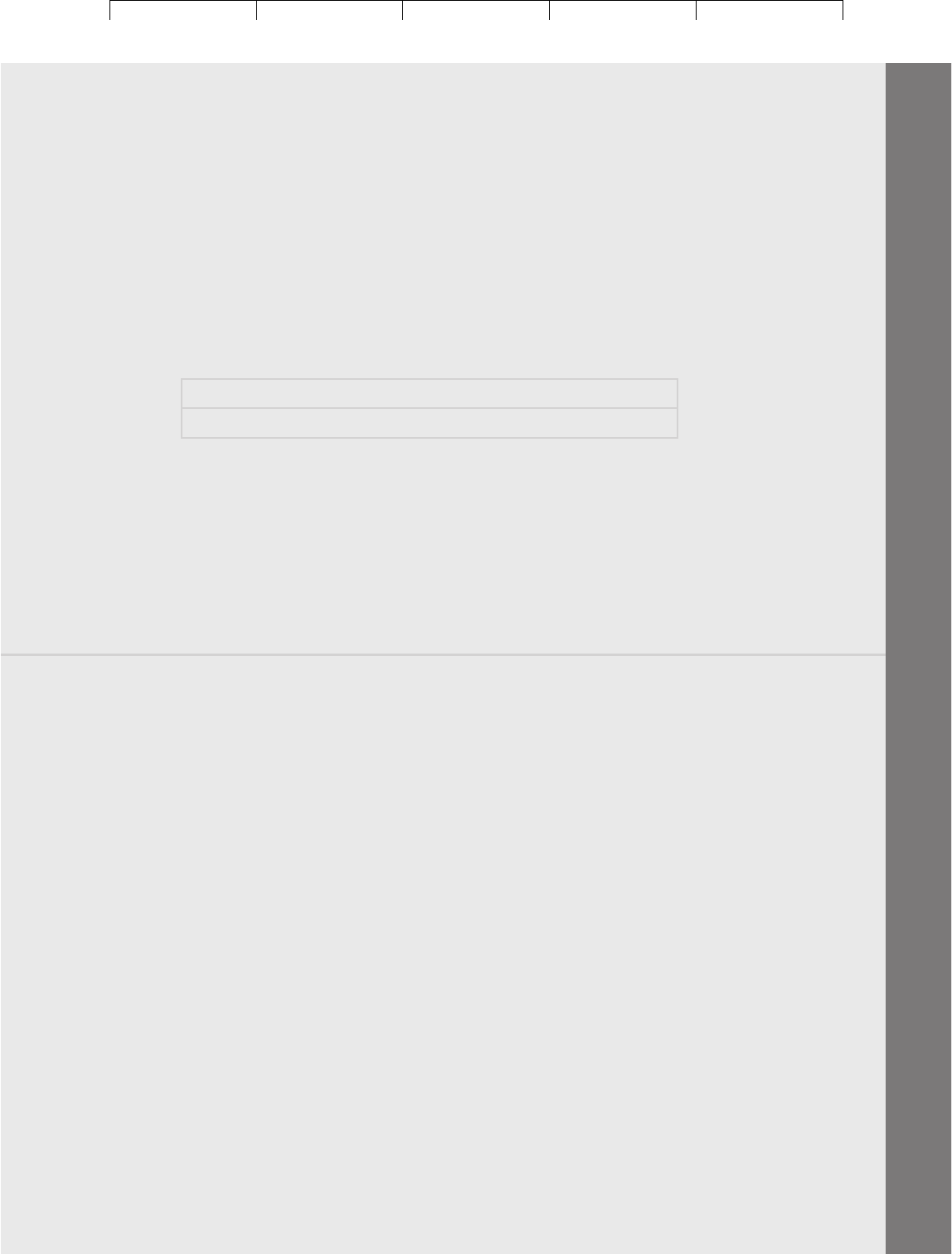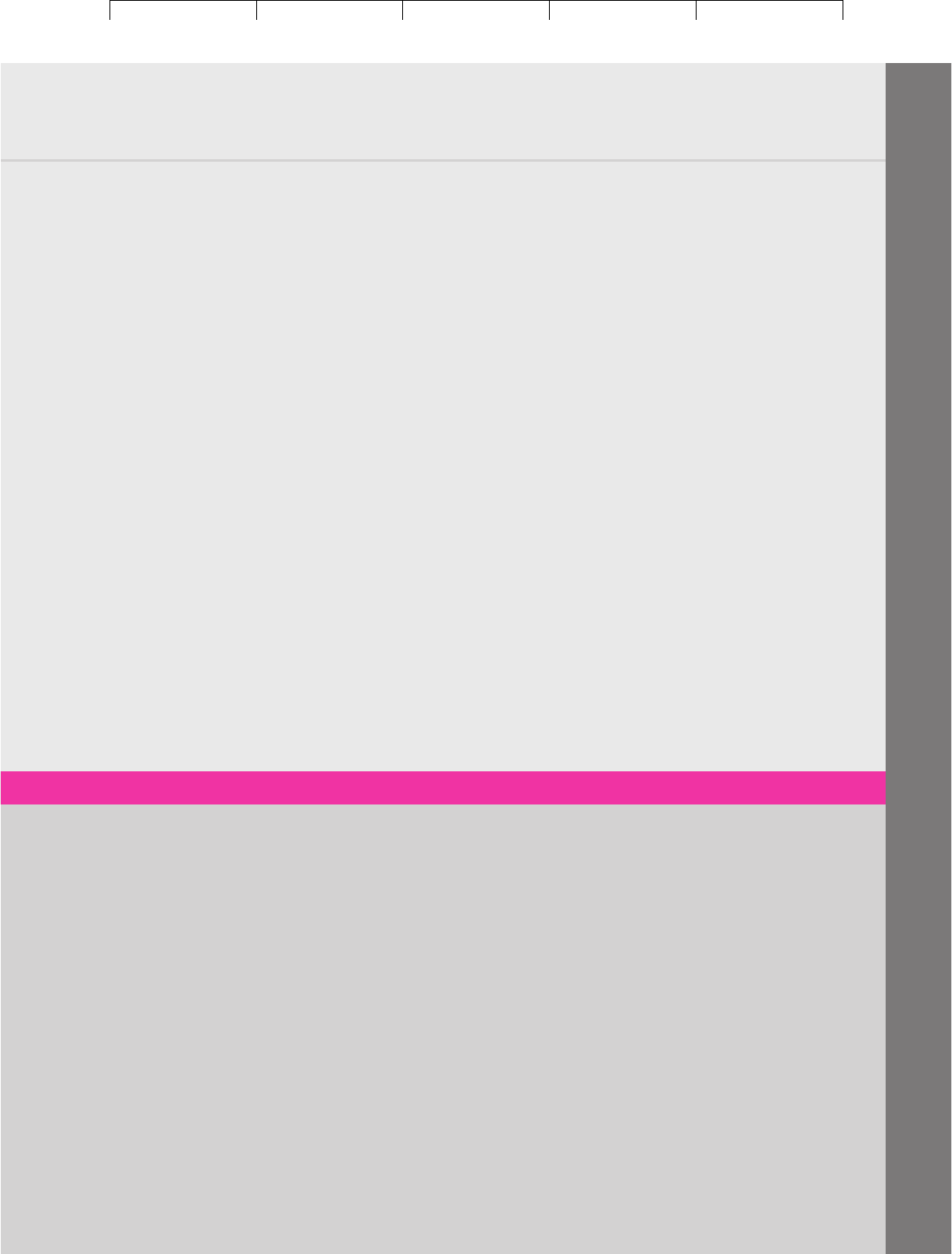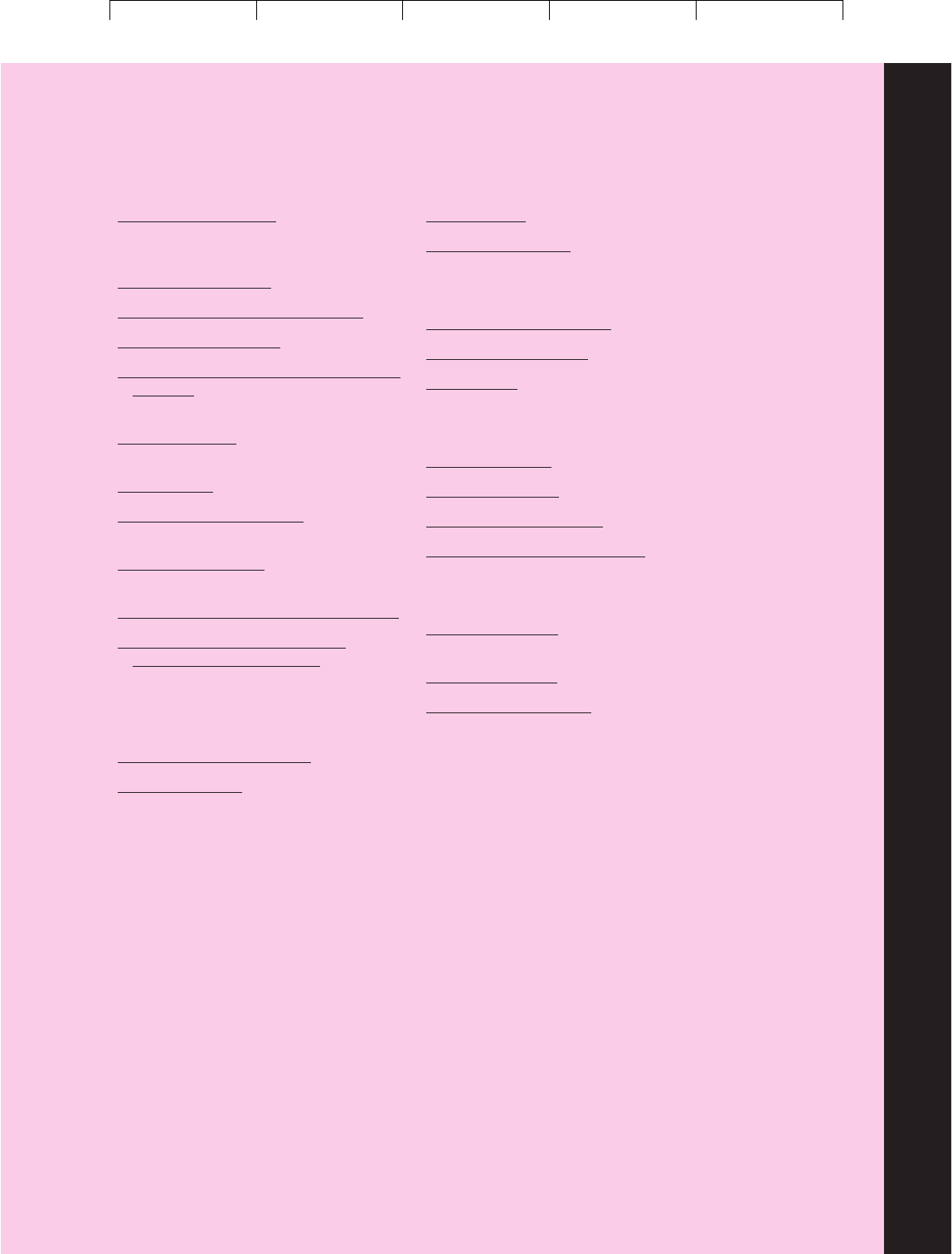Brealey, Myers. Principles of Corporate Finance. 7th edition
Подождите немного. Документ загружается.


Brealey−Meyers:
Principles of Corporate
Finance, Seventh Edition
VII. Debt Financing 26. Leasing
© The McGraw−Hill
Companies, 2003
744 PART VII Debt Financing
of no use to the lessee. However, because the depreciation is accelerated and the in-
terest rate is positive, the government suffers a net loss in the present value of its
tax receipts as a result of the lease.
Now you should begin to understand the circumstances in which the govern-
ment incurs a loss on the lease and the other two parties gain. Other things being
equal, the potential gains to lessor and lessee are highest when
• The lessor’s tax rate is substantially higher than the lessee’s.
• The depreciation tax shield is received early in the lease period.
• The lease period is long and the lease payments are concentrated toward the
end of the period.
• The interest rate is high—if it were zero, there would be no advantage in
present value terms to postponing tax.
Lessors are constantly on the lookout for arrangements that increase the po-
tential gains from leasing. Some of the most ingenious arrangements involve
cross-border leases and take advantage of the fact that different tax authorities
define “ownership” in different ways. For example, suppose that an asset is
bought by a company in Switzerland, which then “leases” the asset to a firm in
the United States. As the legal owner, the company can depreciate the asset for
tax purposes in Switzerland. But the terms of the lease may be such that in the
United States the user of the asset is regarded as the effective owner and therefore
gets to depreciate it for tax purposes. Needless to say, the tax authorities are keen
to prevent such “double-dipping,” but, as soon as one opportunity is blocked off,
another seems to arise.
r
D
SUMMARY
A lease is just an extended rental agreement. The owner of the equipment (the les-
sor) allows the user (the lessee) to operate the equipment in exchange for regular
lease payments.
There is a wide variety of possible arrangements. Short-term, cancelable leases
are known as operating leases. In these leases the lessor bears the risks of ownership.
Long-term, noncancelable leases are called full-payout, financial, or capital leases. In
these leases the lessee bears the risks. Financial leases are sources of financing for as-
sets the firm wishes to acquire and use for an extended period.
The key to understanding operating leases is equivalent annual cost. In a com-
petitive leasing market, the annual operating lease payment will be forced down
to the lessor’s equivalent annual cost. Operating leases are attractive to equipment
users if the lease payment is less than the user’s equivalent annual cost of buying
the equipment. Operating leases make sense when the user needs the equipment
only for a short time, when the lessor is better able to bear the risks of obsolescence,
or when the lessor can offer a good deal on maintenance. Remember too that op-
erating leases often have valuable options attached.
A financial lease extends over most of the economic life of the leased asset and
cannot be canceled by the lessee. Signing a financial lease is like signing a secured
loan to finance purchase of the leased asset. With financial leases, the choice is not
“lease versus buy” but “lease versus borrow.”
Many companies have sound reasons for financing via leases. For example,
companies that are not paying taxes can usually strike a favorable deal with a tax-
Visit us at www.mhhe.com/bm7e

Brealey−Meyers:
Principles of Corporate
Finance, Seventh Edition
VII. Debt Financing 26. Leasing
© The McGraw−Hill
Companies, 2003
CHAPTER 26 Leasing 745
paying lessor. Also, it may be less costly and time-consuming to sign a standard-
ized lease contract than to negotiate a long-term secured loan.
When a firm borrows money, it pays the after-tax rate of interest on its debt.
Therefore, the opportunity cost of lease financing is the after-tax rate of interest on
the firm’s bonds. To value a financial lease, we need to discount the incremental
cash flows from leasing by the after-tax interest rate.
An equivalent loan is one that commits the firm to exactly the same future cash
flows as a financial lease. When we calculate the net present value of the lease, we
are measuring the difference between the amount of financing provided by the
lease and the financing provided by the equivalent loan:
We can also analyze leases from the lessor’s side of the transaction, using the
same approaches we developed for the lessee. If lessee and lessor are in the same
tax bracket, they will receive exactly the same cash flows but with signs reversed.
Thus, the lessee can gain only at the lessor’s expense, and vice versa. However, if
the lessee’s tax rate is lower than the lessor’s, then both can gain at the federal gov-
ernment’s expense.
Value
of lease
⫽
financing provided
by lease
⫺
value of
equivalent loan
FURTHER
READING
A useful general reference on leasing is:
J. S. Schallheim: Lease or Buy? Principles for Sound Decisionmaking, Harvard Business School
Press, Boston, MA, 1994.
The approach to valuing financial leases presented in this chapter is based on:
S. C. Myers, D. A. Dill, and A. J. Bautista: “Valuation of Financial Lease Contracts,” Journal
of Finance, 31:799–819 (June 1976).
J. R. Franks and S. D. Hodges: “Valuation of Financial Lease Contracts: A Note,” Journal of
Finance, 33:647–669 (May 1978).
Other useful works include Nevitt and Fabozzi’s book and the theoretical discussions of Miller and
Upton and of Lewellen, Long, and McConnell:
P. K. Nevitt and F. J. Fabozzi: Equipment Leasing, 4th ed., Frank Fabozzi Associates, 2000.
M. H. Miller and C. W. Upton: “Leasing, Buying and the Cost of Capital Services,” Journal
of Finance, 31:761–786 (June 1976).
W. G. Lewellen, M. S. Long, and J. J. McConnell: “Asset Leasing in Competitive Capital Mar-
kets,” Journal of Finance, 31:787–798 (June 1976).
Harold Bierman gives a detailed account of leasing and the AMT in:
H. Bierman: “Buy versus Lease with an Alternative Minimum Tax,” Financial Management,
17:87–92 (Winter 1988).
The options embedded in many operating leases are discussed in:
T. E. Copeland and J. E. Weston: “A Note on the Evaluation of Cancelable Operating Leases,”
Financial Management, 11:68–72 (Summer 1982).
J. J. McConnell and J. S. Schallheim: “Valuation of Asset Leasing Contracts,” Journal of Fi-
nancial Economics, 12:237–261 (August 1983).
S. R. Grenadier, “Valuing Lease Contracts: A Real Options Approach,” Journal of Financial
Economics, 38:297–331 (July 1995).
Visit us at www.mhhe.com/bm7e

Brealey−Meyers:
Principles of Corporate
Finance, Seventh Edition
VII. Debt Financing 26. Leasing
© The McGraw−Hill
Companies, 2003
746 PART VII Debt Financing
QUIZ
1. The following terms are often used to describe leases:
a. Direct
b. Full-service
c. Operating
d. Financial
e. Rental
f. Net
g. Leveraged
h. Sale and lease-back
i. Full-payout
Match one or more of these terms with each of the following statements:
A. The initial lease period is shorter than the economic life of the asset.
B. The initial lease period is long enough for the lessor to recover the cost of the asset.
C. The lessor provides maintenance and insurance.
D. The lessee provides maintenance and insurance.
E. The lessor buys the equipment from the manufacturer.
F. The lessor buys the equipment from the prospective lessee.
G. The lessor finances the lease contract by issuing debt and equity claims against it.
2. Some of the following reasons for leasing are rational. Others are irrational or assume
imperfect or inefficient capital markets. Which of the following reasons are the ra-
tional ones?
a. The lessee’s need for the leased asset is only temporary.
b. Specialized lessors are better able to bear the risk of obsolescence.
c. Leasing provides 100 percent financing and thus preserves capital.
d. Leasing allows firms with low marginal tax rates to “sell” depreciation tax shields.
e. Leasing increases earnings per share.
f. Leasing reduces the transaction cost of obtaining external financing.
g. Leasing avoids restrictions on capital expenditures.
h. Leasing can reduce the alternative minimum tax.
3. Explain why the following statements are true:
a. In a competitive leasing market, the annual operating lease payment equals the
lessor’s equivalent annual cost.
b. Operating leases are attractive to equipment users if the lease payment is less than
the user’s equivalent annual cost.
4. True or false?
a. Lease payments are usually made at the start of each period. Thus the first
payment is usually made as soon as the lease contract is signed.
b. Financial leases can still provide off-balance-sheet financing.
c. The cost of capital for a financial lease is the interest rate the company would pay
on a bank loan.
d. An equivalent loan’s principal plus after-tax interest payments exactly match the
after-tax cash flows of the lease.
e. A financial lease should not be undertaken unless it provides more financing than
the equivalent loan.
f. It makes sense for firms that pay no taxes to lease from firms that do.
g. Other things equal, the net tax advantage of leasing increases as nominal interest
rates increase.
5. Acme has branched out to rentals of office furniture to start-up companies. Consider a
$3,000 desk. Desks last for six years and can be depreciated on a five-year ACRS sched-
ule (see Table 6.4). What is the break-even operating lease rate for a new desk? Assume
that lease rates for old and new desks are the same and that Acme’s pretax administra-
tive costs are $400 per desk per year. The cost of capital is 9 percent and the tax rate is
Visit us at www.mhhe.com/bm7e

Brealey−Meyers:
Principles of Corporate
Finance, Seventh Edition
VII. Debt Financing 26. Leasing
© The McGraw−Hill
Companies, 2003
CHAPTER 26 Leasing 747
35 percent. Lease payments are made in advance, that is, at the start of each year. The
inflation rate is zero.
6. Refer again to quiz question 5. Suppose a blue-chip company requests a six-year finan-
cial lease for a $3,000 desk. The company has just issued five-year notes at an interest
rate of 6 percent per year. What is the break-even rate in this case? Assume administra-
tive costs drop to $200 per year. Explain why your answers to question 5 and this ques-
tion differ.
7. Suppose that National Waferonics has before it a proposal for a four-year financial
lease. The firm constructs a table like Table 26.2. The bottom line of its table shows the
lease cash flows:
Year 0 Year 1 Year 2 Year 3
Lease cash flow ⫹62,000 ⫺26,800 ⫺22,200 ⫺17,600
These flows reflect the cost of the machine, depreciation tax shields, and the after-tax
lease payments. Ignore salvage value. Assume the firm could borrow at 10 percent and
faces a 35 percent marginal tax rate.
a. What is the value of the equivalent loan?
b. What is the value of the lease?
c. Suppose the machine’s NPV under normal financing is . Should National
Waferonics invest? Should it sign the lease?
⫺$5,000
PRACTICE
QUESTIONS
1. A lessee does not have to pay to buy the leased asset. Thus it’s said that “leases provide
100 percent financing.” Explain why this is not a true advantage to the lessee.
2. In quiz question 5 we assumed identical lease rates for old and new desks.
a. How does the initial break-even lease rate change if the expected inflation rate is 5
percent per year? Assume that the real cost of capital does not change. Hint: Look
at the discussion of equivalent annual costs in Chapter 6.
b. How does your answer to part (a) change if wear and tear force Acme to cut lease
rates by 10 percent in real terms for every year of a desk’s age?
3. Look at Table 26.1. How would the initial break-even operating lease rate change if
rapid technological change in limo manufacturing reduces the costs of new limos by 5
percent per year? Hint: We discussed technological change and equivalent annual costs
in Chapter 6.
4. Why do you think that leasing of trucks, airplanes, and computers is such big business?
What efficiencies offset the costs of running these leasing operations?
5. Financial leases make sense when the lessee faces a lower marginal tax rate than the les-
sor. Does this tax advantage carry over to operating leases?
The following questions all apply to financial leases.
6. Look again at the bus lease described in Table 26.2.
a. What is the value of the lease if Greymare’s marginal tax rate is ?
b. What would the lease value be if Greymare had to use straight-line depreciation
for tax purposes?
7. In Section 26.4 we showed that the lease offered to Greymare Bus Lines had a positive
NPV of $820 if Greymare paid no tax and a NPV to a lessor paying 35 percent tax.
What is the minimum lease payment the lessor could accept under these assumptions?
What is the maximum amount that Greymare could pay?
⫹$700
T
c
⫽ .20
Visit us at www.mhhe.com/bm7e

Brealey−Meyers:
Principles of Corporate
Finance, Seventh Edition
VII. Debt Financing 26. Leasing
© The McGraw−Hill
Companies, 2003
748 PART VII Debt Financing
Visit us at www.mhhe.com/bm7e
8. In Section 26.5 we listed four circumstances in which there are potential gains from leas-
ing. Check them out by conducting a sensitivity analysis on the Greymare Bus Lines
lease, assuming that Greymare does not pay tax. Try, in turn, (a) a lessor tax rate of 50
percent (rather than 35 percent), (b) immediate 100 percent depreciation in year 0
(rather than five-year ACRS), (c) a three-year lease with four annual rentals (rather than
an eight-year lease), and (d) an interest rate of 20 percent (rather than 10 percent). In
each case, find the minimum rental that would satisfy the lessor and calculate the NPV
to the lessee.
9. In Section 26.5 we stated that if the interest rate were zero, there would be no advan-
tage in postponing tax and therefore no advantage in leasing. Value the Greymare Bus
Lines lease with an interest rate of zero. Assume that Greymare does not pay tax. Can
you devise any lease terms that would make both a lessee and a lessor happy? (If you
can, we would like to hear from you.)
10. A lease with a varying rental schedule is known as a structured lease. Try structuring the
Greymare Bus Lines lease to increase value to the lessee while preserving the value to
the lessor. Assume that Greymare does not pay tax. (Note: In practice the tax authorities
will allow some structuring of rental payments but might be unhappy with some of the
schemes you devise.)
11. Nodhead College needs a new computer. It can either buy it for $250,000 or lease it from
Compulease. The lease terms require Nodhead to make six annual payments (prepaid)
of $62,000. Nodhead pays no tax. Compulease pays tax at 35 percent. Compulease can
depreciate the computer for tax purposes over five years. The computer will have no
residual value at the end of year 5. The interest rate is 8 percent.
a. What is the NPV of the lease for Nodhead College?
b. What is the NPV for Compulease?
c. What is the overall gain from leasing?
12. The Safety Razor Company has a large tax-loss carryforward and does not expect to pay
taxes for another 10 years. The company is therefore proposing to lease $100,000 of new
machinery. The lease terms consist of eight equal lease payments prepaid annually. The
lessor can write the machinery off over seven years using the tax depreciation sched-
ules given in Table 6.4. There is no salvage value at the end of the machinery’s economic
life. The tax rate is 35 percent, and the rate of interest is 10 percent. Wilbur Occam, the
president of Safety Razor, wants to know the maximum lease payment that his com-
pany should be willing to make and the minimum payment that the lessor is likely to
accept. Can you help him? How would your answer differ if the lessor was obliged to
use straight-line depreciation?
13. The overall gain from leasing is the sum of the lease’s value to the lessee and its
value to the lessor. Construct simple numerical examples showing how this gain is
affected by
a. The rate of interest.
b. The choice of depreciation schedule.
c. The difference between the tax rates of the lessor and lessee.
d. The length of the lease.
14. Many companies calculate the internal rate of return of the incremental after-tax cash
flows from financial leases. What problems do you think this may give rise to? To what
rate should the IRR be compared?
15. Discuss the following two opposite statements. Which do you think makes more sense?
a. “Leasing is tax avoidance and should be legislated against.”
b. “Leasing ensures that the government’s investment incentives work. It does so by
allowing companies in nontaxpaying positions to take advantage of depreciation
allowances.”

Brealey−Meyers:
Principles of Corporate
Finance, Seventh Edition
VII. Debt Financing 26. Leasing
© The McGraw−Hill
Companies, 2003
CHAPTER 26 Leasing 749
CHALLENGE
QUESTIONS
1. Magna Charter has been asked to operate a Beaver bush plane for a mining company
exploring north and west of Fort Liard. Magna will have a firm one-year contract with
the mining company and expects that the contract will be renewed for the five-year du-
ration of the exploration program. If the mining company renews at year 1, it will com-
mit to use the plane for four more years.
Magna Charter has the following choices.
•
Buy the plane for $500,000.
•
Take a one-year operating lease for the plane. The lease rate is $118,000, paid in
advance.
•
Arrange a five-year, noncancelable financial lease at a rate of $75,000 per year, paid
in advance.
These are net leases: all operating costs are absorbed by Magna Charter.
How would you advise Agnes Magna, the charter company’s CEO? For simplicity
assume five-year, straight-line depreciation for tax purposes. The company’s tax rate is
35 percent. The weighted-average cost of capital for the bush-plane business is 14 per-
cent, but Magna can borrow at 9 percent. The expected inflation rate is 4 percent.
Ms. Magna thinks the plane will be worth $300,000 after five years. But if the con-
tract with the mining company is not renewed (there is a 20 percent probability of this
outcome at year 1), the plane will have to be sold on short notice for $400,000.
If Magna Charter takes the five-year financial lease and the mining company can-
cels at year 1, Magna can sublet the plane, that is, rent it out to another user.
Make additional assumptions as necessary.
2. Here is a variation on challenge question 1. Suppose Magna Charter is offered a five-
year cancelable lease at an annual rate of $125,000, paid in advance. How would you go
about analyzing this lease? You do not have enough information to do a full option pric-
ing analysis, but you can calculate costs and present values for different scenarios.
3. Recalculate the value of the lease to Greymare Bus Lines if the company pays no taxes un-
til year 3. Calculate the lease cash flows by modifying Table 26.2. Remember that the
after-tax borrowing rate for periods 1 and 2 differs from the rate for periods 3 through 7.
MINI-CASE
Visit us at www.mhhe.com/bm7e
Halverton Corporation
Helen James, a newly recruited financial analyst at Halverton Corporation, had just been
asked to analyze a proposal to acquire a new dredger.
She reviewed the capital appropriation request. The dredger would cost $3.5 million and
was expected to generate cash flows of $470,000 a year for nine years. After that point, the
dredger would almost surely be obsolete and have no significant salvage value. The com-
pany’s weighted-average cost of capital was 16 percent.
Helen proposed a standard DCF analysis, but this suggestion was brushed off by Halver-
ton’s top management. They seemed to be convinced of the merits of the investment but
were unsure of the best way to finance it. Halverton could raise the money by issuing a se-
cured eight-year note at an interest rate of 12 percent. However, Halverton had large tax-loss
carryforwards from a disastrous foray into foreign exchange options. As a result, the com-
pany was unlikely to be in a tax-paying position for many years. Halverton’s CEO thought
it might be better to lease the dredger than to buy it.
Helen’s first step was to invite two leasing companies, Mount Zircon Finance and First
Cookham Bank, to submit proposals. Both companies were in a tax-paying position and
could write off their investment in the dredger using five-year MACRS tax depreciation.

Brealey−Meyers:
Principles of Corporate
Finance, Seventh Edition
VII. Debt Financing 26. Leasing
© The McGraw−Hill
Companies, 2003
750 PART VII Debt Financing
Visit us at www.mhhe.com/bm7e
Helen received the following letters, the first from Mount Zircon Finance:
February 29, 2006
Dear Helen,
We appreciated the opportunity to meet you the other day and to discuss the possibility of provid-
ing lease finance for your proposed new JLT4 dredger. As you know, Mount Zircon has extensive ex-
perience in this field and, because of our large volumes and low borrowing costs, we are able to offer
very attractive terms.
We would envisage offering a 9-year lease with 10 annual payments of $544,300, with the initial
lease payment due on entering into the lease contract. This is equivalent to a borrowing cost of 11.5
percent per annum (i.e., 10 payments of $544,300 paid at the beginning of each year discounted at
11.5 percent amounts to $3,500,000).
We hope that you agree with us that this is an attractive rate. It is well below your company’s over-
all cost of capital. Our leasing proposal will cover the entire $3.5 million cost of the dredger, thereby
preserving Halverton’s capital for other uses. Leasing will also allow a very attractive return on eq-
uity from your company’s acquisition of this new equipment.
This proposal is subject to a routine credit check and review of Halverton’s financial statements.
We expect no difficulties on that score, but you will understand the need for due diligence.
Thank you for contacting Mount Zircon Finance. We look forward to hearing your response.
Sincerely yours,
Henry Attinger
For and on behalf of Mount Zircon Finance
The next letter was from First Cookham.
February 29, 2006
Dear Helen,
It was an honor to meet you the other day and to discuss how First Cookham Bank can help your
company to finance its new dredger. First Cookham has a small specialized leasing operation. This en-
ables us to tailor our proposals to our clients’ needs.
We recommend that Halverton consider leasing the dredger on a 7-year term. Subject to docu-
mentation and routine review of Halverton’s financial statements, we could offer a 7-year lease on the
basis of 8 payments of $619,400 due at the beginning of each year. This is equivalent to a loan at an
interest rate of 11.41 percent.
We expect that this lease payment will be higher than quoted by the larger, mass-market leasing
companies, but our financial analysts have determined that, by offering a shorter lease, we can quote
a lower interest rate.
We are confident that this is a highly competitive offer, and we look forward to your response.
Yours sincerely,
George Bucknall,
First Cookham Bank
Both proposals appeared to be attractive. However, Helen realized the need to undertake
careful calculations before deciding whether leasing made sense and which firm was offer-
ing the better deal. She also wondered whether the terms offered were really as attractive as
the two lessors claimed. Perhaps she could persuade them to cut their prices.
Questions
1. Calculate the NPV to Halverton of the two lease proposals.
2. Does the dredger have a positive NPV with (a) ordinary financing, (b) lease financing?
3. Calculate the NPVs of the leases from the lessors’ viewpoints. Is there a chance that they
could offer more attractive terms?
4. Evaluate the arguments presented by each of the lessors.

Brealey−Meyers:
Principles of Corporate
Finance, Seventh Edition
VII. Debt Financing 26. Leasing
© The McGraw−Hill
Companies, 2003
RELATED WEBSITES
Useful material and data on bond markets are
available on:
www
.bondmarkets.com
(website of the Bond
Market Association. Includes useful
statistics)
www
.bondsonline.com
www
.bondresources.com/main.html
http:
//bonds.yahoo.com
www.duke.edu/~charvey/applets/Bond/
test.html (nice graphics illustrating effect of
interest rate on bond prices)
www
.finpipe.com (explanations of bond
markets)
www
.hsh.com
www
.investinginbonds.com
(also contains
links to related sites)
www
.loanpricing.com (useful statistics on
corporate bond issuance)
http:
//money.cnn.com/markets/bondcenter
http:
//ourworld.compuserve.com/
homepages/martinhighmore (bond
calculator)
The websites of the ratings services provide
information and data on bond risk:
www
.standardandpoors.com
www
.moodys.com
For material on the estimation of default
probabilities see:
www
.kmv.com
www
.riskmetrics.com
Here are some sites that focus on project
finance:
www
.hbs.edu/projfinportal
www
.infrastructure.com
www
.ipfa.org
For material on bankruptcies and bankruptcy
procedures see:
www
.abiworld.org
www
.bankrupt.com
www
.bankruptcydata.com
www
.law.cornell.edu/uscode/11
(a
technical description of the bankruptcy code)
The following sites contain material on leasing:
www
.elaonline.com (the site for the
Equipment Leasing Association)
www
.gecapital.com
www
.leasingcanada.com
(includes a lease
calculator)
PART SEVEN
RELATED
WEBSITES

Brealey−Meyers:
Principles of Corporate
Finance, Seventh Edition
VIII. Risk Management 27. Managing Risk
© The McGraw−Hill
Companies, 2003
CHAPTER TWENTY-SEVEN
754
MANAGING RISK

Brealey−Meyers:
Principles of Corporate
Finance, Seventh Edition
VIII. Risk Management 27. Managing Risk
© The McGraw−Hill
Companies, 2003
MOST OF THE time we take risk as God-given. An asset or business has its beta, and that’s that. Its
cash flow is exposed to unpredictable changes in raw material costs, tax rates, technology, and a long
list of other variables. There’s nothing the manager can do about it.
That’s not wholly true. To some extent managers can choose the risks that the business takes. We
have already come across one way that they can do so. In our discussion of real options in Chapter 22
we described how companies reduce risk by building flexibility into their operations. A company that
uses standardized machine tools rather than specialized equipment lowers the cost of bailing out if
things go wrong. A petrochemical plant that is designed to use either oil or natural gas as a feedstock
reduces the impact of an unfavorable shift in relative fuel prices. And so on.
In this chapter we shall explain how companies also enter into financial contracts that insure against or
hedge (i.e., offset) a variety of business hazards. But first we should give some reasons why they do so.
Insurance and hedging are seldom free: At best they are zero-NPV transactions.
1
Most businesses
insure or hedge to reduce risk, not to make money. Why, then, bother to reduce risk in this way? For
one thing, it makes financial planning easier and reduces the odds of an embarrassing cash shortfall. A
shortfall might mean only an unexpected trip to the bank, but if financing is hard to obtain on short no-
tice, the company might need to cut back its capital expenditure program. In extreme cases an un-
hedged setback could trigger financial distress or even bankruptcy. Banks and bondholders are aware
of this possibility, and, before lending to your firm, they will often insist that it is properly insured.
In some cases hedging also makes it easier to decide whether an operating manager deserves a
stern lecture or a pat on the back. Suppose your confectionery division shows a 60 percent profit in-
crease in a period when cocoa prices decline by 12 percent. How much of the increase is due to the
change in cocoa prices and how much to good management? If cocoa prices were hedged, it’s prob-
ably good management. If they were not, things have to be sorted out with hindsight by asking, What
would profits have been if cocoa prices had been hedged?
2
Finally, hedging extraneous events can help focus the operating manager’s attention. It’s naive to
expect the manager of the confectionery division not to worry about cocoa prices if her bottom line
and bonus depend on them. That worrying time would be better spent if the prices were hedged.
3
Of course, managers are not paid to avoid all risks, but if they can reduce their exposure to risks
for which there are no compensating rewards, they can afford to place larger bets when the odds are
in their favor.
755
1
Hedging transactions are zero-NPV when trading is costless and markets are completely efficient. In
practice the firm has to pay small trading costs at least.
2
Many large firms insure or hedge away operating divisions’ risk exposures by setting up internal, make-
believe markets between each division and the treasurer’s office. Trades in the internal markets are at real
(external) market prices. The object is to relieve the operating managers of risks outside their control. The
treasurer makes a separate decision on whether to offset the firm’s exposure.
3
A Texas oilman who lost hundreds of millions in ill-fated deals protested, “Why should I worry? Worry
is for strong minds and weak characters.” If there are any financial managers with weak minds and
strong characters, we especially advise them to hedge whenever they can.
27.1 INSURANCE
Most businesses buy insurance against a variety of hazards—the risk that their plant
will be damaged by fire; that their ships, planes, or vehicles will be involved in acci-
dents; that the firm will be held liable for environmental damage; and so on.
